Embroidered clothes in India
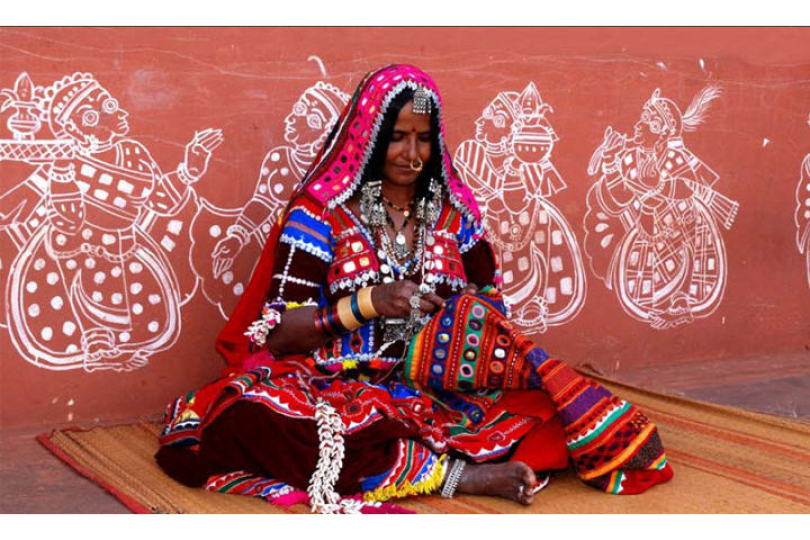
The main features of Indian embroidery lie in a great desire to decorate clothes, thus revealing the national uniqueness and exquisite taste. The first records of embroidery as a craft date back to the 5th century BC and can be found in the Old Indian “The Vedas”.
Modern Indian embroidery reflects a difficult history of this extremely interesting country.
The history of the Indian embroidery
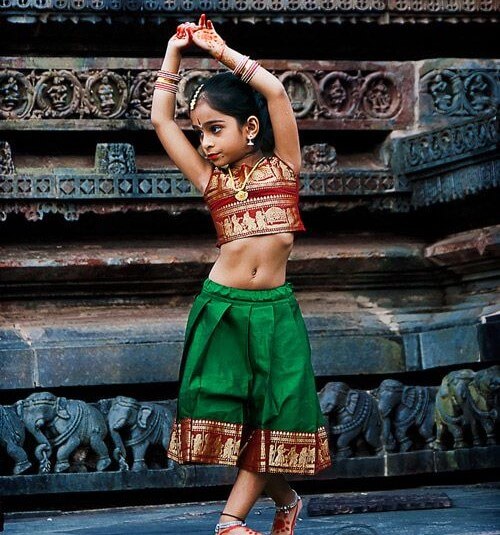
The main feature of Indian embroidery is that it has absorbed a lot of traditional elements of the cultures of other nations. Moreover, craftswomen quite creatively approached the process of pattern assimilation and embroidery techniques.
For example, Chinese merchants selling a wide range of goods brought to India a habit to use gold and silver embroidery while decorating their clothes. It should be noted that people of India liked brightly embroidered things. However, they did not copy Chinese patterns blindly, but neatly used the manner of precious embroidery according to their national traditions and customs.
India has also adopted the Chinese manner of embroidery in satin stitch. This technique has gone through a thorny path of improvements and numerous transformations. As a result, it became one of the most widespread and beloved technique. Today traditional clothes of Indian women known as sari is decorated with purely national patterns embroidered in satin stitch. The uniqueness of sari is that a 9-meter length of cloth is wrapped around a woman’s body to make it match soft pleats. Broad borders on the edge of the cloth are embroidered with a variety of patterns, adding sophistication and elegance to the clothes.
Another borrowing entering the Indian embroidery is a flower picture brought to India by Muslims. Local women liked patterned and embroidered fabric. As a result, they became widely used for sewing not only festive, but also everyday clothing.
Time passed and the craftswomen began to add purely national features to the embroidered clothes, namely:
- original stitches;
- small mirrors;
- shiny pebbles;
- wires made of different metals;
- silk threads.
The use of embroidery in Indian clothes
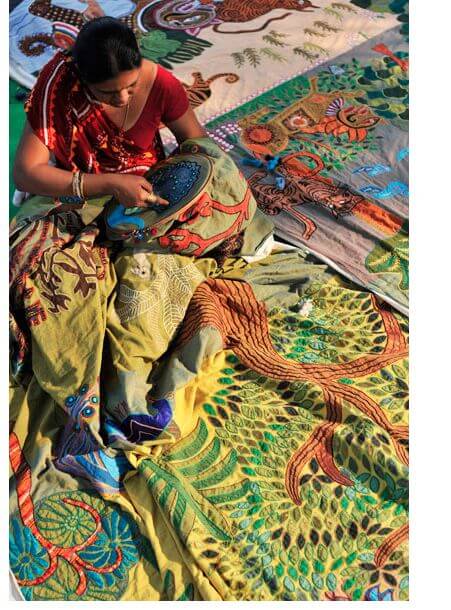
As a rule, the traditional women’s dress – sari – is used for embroidery. The one-colour cloth is decorated with flowers, exotic plants, birds, and geometric patterns. Silver or gold threads are used, adding rhinestones or beads.
In addition to sari, Indian women wear modern dresses that are also decorated with pattern embroidery. Bright embroidery makes clothes not only festive, but also extremely refined. Moreover, the exquisite taste of Indian women can prove elegantly embroidered bags, clutches, purses, cases for glasses, etc. Well, we should not forget about men whose suits are also decorated with embroidery.
Men’s traditional long shirt known as kurta is embroidered on the sleeves and hem. This shirt has no collar, but low neck must be embroidered in any case. Indian men wear a knee-long jacket over the shirt. In this case, flight of fancy is almost unlimited, because jacket flaps, stolling, sleeves, pockets and back can be decorated with embroidery.
It is impossible even to imagine Indian wedding clothing without embroidery. Symbols as amulets, as well as in Ukraine, are embroidered on bridal gowns to protect them from the evil eye and predict a happy married life.
In addition to the everyday and festive clothes, people of Indian love to embroider hats and shoes. This is a significant distinguishing feature of the representatives of this nation, since this manner of decoration is characteristic of them only.
Ready-made embroidery by Indian craftswomen impress with its unique refinement, richness and elegance.
A distinguishing feature of Indian embroidery lies in the fact that each region of the country can boast of its own colour. One region uses only natural silk threads, the other one uniquely combines the colours. In addition, there are some regions where people know the way to embroider specific symbols, thus making them helpful for the owner of the clothes, etc.
Indian embroidery is a thin bridge between history and modern times that not only connects many generations, but also teaches them to love their country, respect their traditions and be proud of their ancestors.
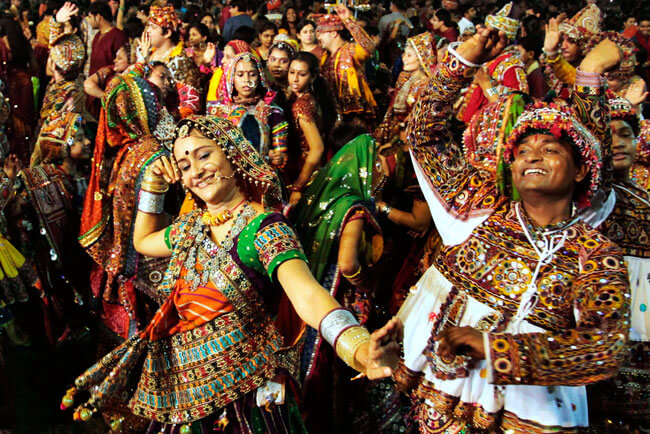
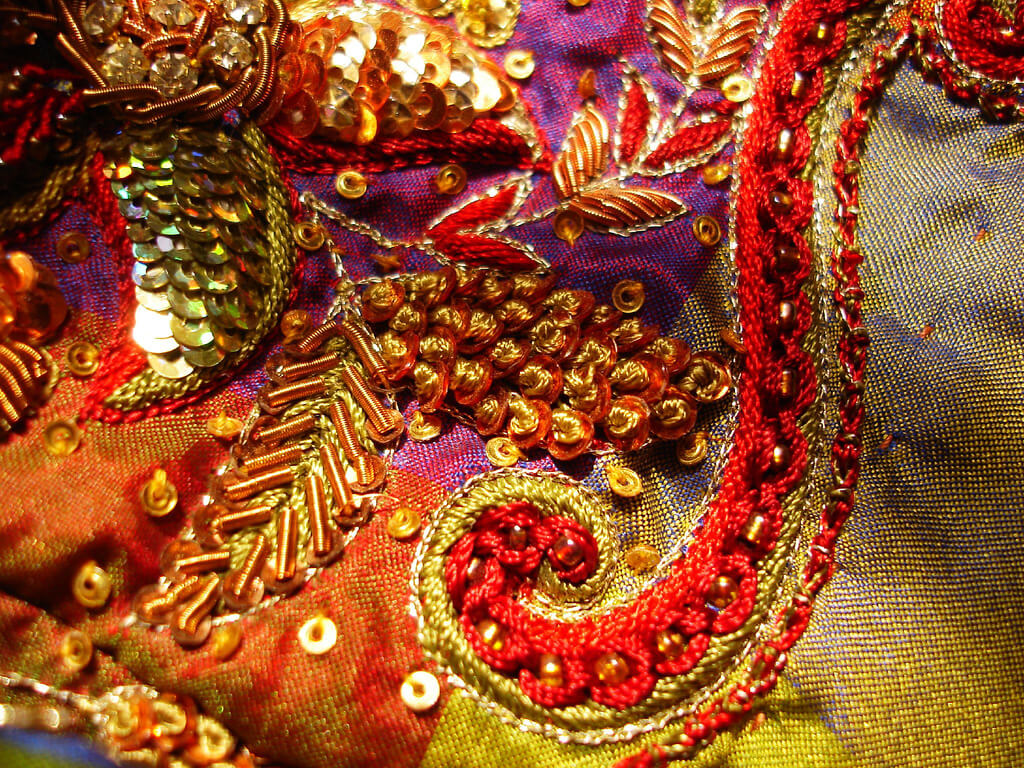
The main features of Indian embroidery lie in a great desire to decorate clothes, thus revealing the national uniqueness and exquisite taste. The first records of embroidery as a craft date back to the 5th century BC and can be found in the Old Indian “The Vedas”.
Modern Indian embroidery reflects a difficult history of this extremely interesting country.
The history of the Indian embroidery

The main feature of Indian embroidery is that it has absorbed a lot of traditional elements of the cultures of other nations. Moreover, craftswomen quite creatively approached the process of pattern assimilation and embroidery techniques.
For example, Chinese merchants selling a wide range of goods brought to India a habit to use gold and silver embroidery while decorating their clothes. It should be noted that people of India liked brightly embroidered things. However, they did not copy Chinese patterns blindly, but neatly used the manner of precious embroidery according to their national traditions and customs.
India has also adopted the Chinese manner of embroidery in satin stitch. This technique has gone through a thorny path of improvements and numerous transformations. As a result, it became one of the most widespread and beloved technique. Today traditional clothes of Indian women known as sari is decorated with purely national patterns embroidered in satin stitch. The uniqueness of sari is that a 9-meter length of cloth is wrapped around a woman’s body to make it match soft pleats. Broad borders on the edge of the cloth are embroidered with a variety of patterns, adding sophistication and elegance to the clothes.
Another borrowing entering the Indian embroidery is a flower picture brought to India by Muslims. Local women liked patterned and embroidered fabric. As a result, they became widely used for sewing not only festive, but also everyday clothing.
Time passed and the craftswomen began to add purely national features to the embroidered clothes, namely:
- original stitches;
- small mirrors;
- shiny pebbles;
- wires made of different metals;
- silk threads.
The use of embroidery in Indian clothes

As a rule, the traditional women’s dress – sari – is used for embroidery. The one-colour cloth is decorated with flowers, exotic plants, birds, and geometric patterns. Silver or gold threads are used, adding rhinestones or beads.
In addition to sari, Indian women wear modern dresses that are also decorated with pattern embroidery. Bright embroidery makes clothes not only festive, but also extremely refined. Moreover, the exquisite taste of Indian women can prove elegantly embroidered bags, clutches, purses, cases for glasses, etc. Well, we should not forget about men whose suits are also decorated with embroidery.
Men’s traditional long shirt known as kurta is embroidered on the sleeves and hem. This shirt has no collar, but low neck must be embroidered in any case. Indian men wear a knee-long jacket over the shirt. In this case, flight of fancy is almost unlimited, because jacket flaps, stolling, sleeves, pockets and back can be decorated with embroidery.
It is impossible even to imagine Indian wedding clothing without embroidery. Symbols as amulets, as well as in Ukraine, are embroidered on bridal gowns to protect them from the evil eye and predict a happy married life.
In addition to the everyday and festive clothes, people of Indian love to embroider hats and shoes. This is a significant distinguishing feature of the representatives of this nation, since this manner of decoration is characteristic of them only.
Ready-made embroidery by Indian craftswomen impress with its unique refinement, richness and elegance.
A distinguishing feature of Indian embroidery lies in the fact that each region of the country can boast of its own colour. One region uses only natural silk threads, the other one uniquely combines the colours. In addition, there are some regions where people know the way to embroider specific symbols, thus making them helpful for the owner of the clothes, etc.
Indian embroidery is a thin bridge between history and modern times that not only connects many generations, but also teaches them to love their country, respect their traditions and be proud of their ancestors.



Comments
No comment at this time!
Leave your comment